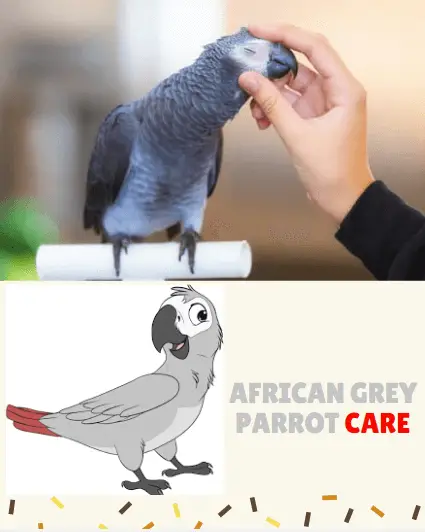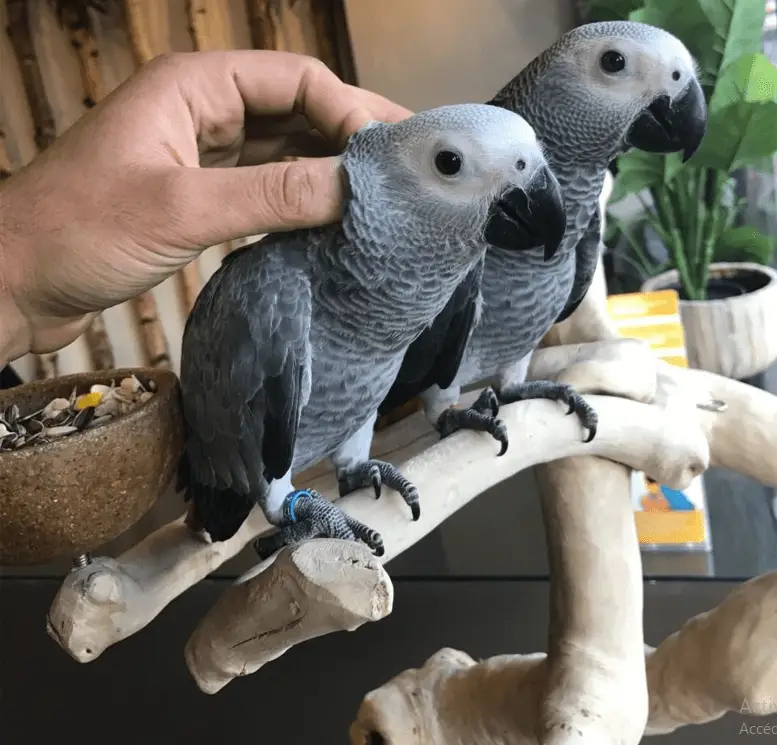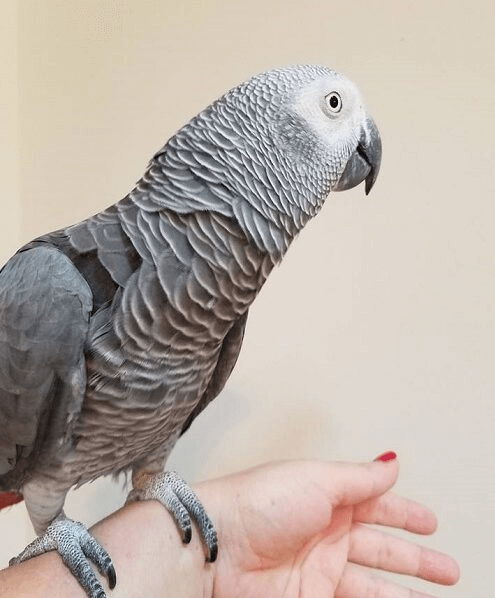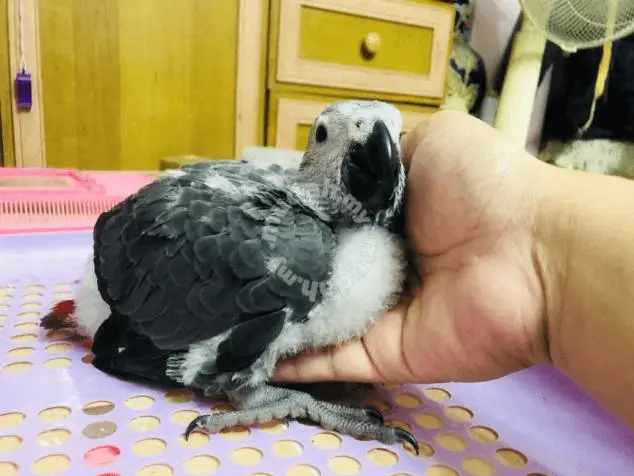
How To Take Care Of African Grey Parrots? The African Grey parrot is a very special bird. He’s very smart. This bird has a remarkable ability to understand and imitate with amazing precision. His ability to repeat the things heard makes him exceptional. It easily reproduces the sounds that the environment emits.
He is very grateful, captive, and affectionate towards his master. He is a companion like others who demand that environmental, physiological, and nutritional needs be met so that he can give him a comfortable life.
He needs environmental stability because he is a bird that loves routine. This companion bird, for a relational development of trust and serenity, needs regularity in interactions.
How do you go about caring for this parrot?

The characteristics of the Parrot African Grey
The Gabonese gray parrot is also called the Jaco parrot or African Grey or African Parrot and is part of the Psittacidae family. This family includes parakeets, lovebirds, parrots, and others. It is found in two subspecies. It is native to Central Africa and West Africa.
It weighs between 350 and 500 g. The young Gabonese parrot exhibits a dark gray color of the eye iris and a pale yellow color when it reaches the age of one year. Its sexual maturity is between 2 and 4 years. Its life expectancy is 30 years and sometimes exceeds 50 years.
African grey parrot behavior
This parrot has a fearful and intolerant attitude towards strangers. It is an exclusive bird that attaches itself to one person and rejects other members of the family.
Those that have been trained by several people are often more balanced with the family. When it reaches maturity, it becomes aggressive and no longer fears humans and there is regular pecking.
He can be socialized with other animals. It can also be trained to do household chores. It is an animal that is able to adapt to any environment.
He is very intelligent and his curiosity is immense. He likes to explore his surroundings in depth. He enjoys playing a lot and this allows him to limit dysfunctions in his behavior.
He does not like changes to be made in his environment. They are also against sound effects.
- The Grays of Gabon are very exclusive, they mostly bond with one family member and reject others.
- The African Grey Parrot is relatively fearful and intolerant of strangers
- Newborns educated by parents tend to be more balanced than those educated completely by humans when they reach maturity (problems of aggression, lack of fear of humans, chronic pecking, etc.).
- The parrots that are at ease in an environment with humans will adapt better to a new environment and new activities, which is why we must socialize them from their infancy to people and other animals, as well as ‘to the daily chores of the house.
- The Grays of Gabon is very intelligent, curious, and love to explore their surroundings.
- They need an environment enriched with games, perches, and exercises in order to feel good and to limit the risk of behavioral problems.
- Gabonese Grays are very routine animals who have difficulty accepting changes in their environment. Therefore, new perches and games should be placed outdoors and gradually moved indoors.
- The African Grey Parrot shows their discontent through loud “grunts”.
What is the character and behavior of the African Grey?

In addition to its physical traits, the Gabonese gray parrot has easily recognized thanks to a few specific character traits:
- Loud talker and intelligent: the African Grey is among the most talkative species of parrot. Intelligent and curious, he is able to quickly learn and repeat the words his master teaches him by reproducing them in the right contexts. This parrot is also able to learn the sounds which surround it such as the barking of a dog, the hissing of certain songs, or the ringing of a telephone or the front door.
- Affectionate: Although this pet bird is naturally shy, it appreciates family life. By giving him time to adapt to those around him, he can easily express his affection. In the event that his master is absent, he must leave the television or radio on so that he does not feel alone. Hearing human voices, this animal will have the impression that someone is present in the house. You should know that loneliness can lead to depression. He asks to be stimulated by words or games.
- Sociable: to feel comfortable, the cheerful and cheerful Gabonese gray needs to interact with his adoptive family on a daily basis. In fact, in its natural environment, it is used to evolving in a large group of several hundred members.
- Docile: this pet bird is easy to train. Once well educated, it is possible to let this parrot come out of its cage so that it can explore its environment. However, you should not let him out of the house and ensure that he is under increased surveillance if you do not wish to lose sight of him.
- Faithful: the Gabonese gray parrot is very loyal to its natural environment. Throughout his life, he keeps the same partner.
- Active and playful: Due to its active nature, this bird must have a cage spacious enough for it to move around. Inside his shelter, the master must also set up toys or perches made with natural wood.
Care of African grey parrot

African grey parrot care
This parrot feeds on nuts, plants, and fruits. For better food nutrition, it is not good to give it seeds as its main food. It can be done, but in small amounts and they will not be the staple food.
There are foods on the market that are available that provide a balanced ratio. These foods must represent 75% of the bird’s ratio. Plants should represent 20 or 25% of the parrot’s ratio.
It is not good that the treats and delicacies exceed the rate of 5% in his ratio. It is good to always change the water from time to time, but the water must be fresh and accompanied by remarkable cleanliness. Allow him to have a drinker outside his cage so that he does not drop his droppings in the water.
You have to choose the parrot cage to allow it to be comfortable. It should be large, clean, with wooden perches. It must be secure.
It is necessary to opt for natural light and ultraviolet lamps so as not to damage the feathers of the bird. He is quite used to solitude because he adapts.
It is good to give him preventive care and veterinary consultations in order to keep the bird in good health.
African grey parrot care sheet
SOURCE:Howcast
African grey parrot species
Also called African Parrot, the Gray Parrot of Gabon belongs to the Psittacidae family comprising parrots, parakeets, lovebirds, etc. It is represented by two subspecies:
- Psittacus erithacus Erithacus Linnaeus, known as the Congo parrot: it is larger with light gray plumage, a black beak, and a bright red tail.
- Psittacus erithacus timneh Fraser, known as Timneh’s parrot: smaller, its plumage is dark gray, its flesh-colored beak on the upper half, and its tail dark brown.
- Average weight: 350 to 500gr.
- The irises of the eyes of young parrots are dark gray and turn pale yellow around one year of age.
- Sexual maturity: between 2 and 4 years.
- Life expectancy: 30 years (up to a maximum of 50 years, or even more)
- Origins: Central and West Africa
- African Grey Price (between $ 1,600 and $ 3,600)
African grey parrot food
- Wild parrots feed on fruits, nuts, and plants.
- A varied diet for African grey parrots close to that of their wild colleagues is recommended.
- A seed-based diet is not recommended as the main food but can be given in small quantities (parrot seeds)
- Commercial granulated feed is available which provides a complete and balanced ratio and avoids sorting. They should constitute at least 75% of the parrot’s ratio.
- Plants and fruits should make up 20-25% of the ratio.
- Treats and delicacies should not exceed 5% of the parrot’s ration.
- The water should be changed very regularly and be kept clean and fresh. It is recommended to provide a drinking trough external to the cage to prevent the animal from shedding its droppings inside.
What does the African Grey parrot eat?
The Gabonese gray parrot must be fed a quality and well-balanced diet. To meet its nutritional needs, it must be fed with seeds. His master can get a mixture specially developed for this breed of bird in pet stores.
On the other hand, since this bird risks sorting them, it can expose itself to a nutritional deficiency. Therefore, it is essential to supplement your diet with fresh fruit and cereal bars several times a week.
This bird also needs a supply of calcium and minerals. To meet this need, his master can enhance his diet with a mineral stone.
To ensure his hydration, he needs fresh water daily. Once a week, it is necessary to incorporate a few drops of a vitamin complex in its water to overcome the risks of deficiencies, but also to preserve the beauty of its plumage.
African grey parrot cage
- The cage should be as wide as possible so that the parrot spreads its wings without touching the bars.
- It must be clean, secure, made of solid material, and non-toxic to the animal.
- Perches made of natural wood are preferred. Try to vary the sizes, weights, and heights. To avoid mold and also avoid placing them under the water and feeder.
- It is better to opt for natural light, with an ultraviolet lamp in less sunny regions to avoid hypocalcemia and pathologies of the plumage.
- Animals without access restrictions are more at risk for household accidents, poisoning, and assault.
African grey parrot toys
The best cage for your African grey parrot must be ready before your parrot arrives. Place it in a pleasant and lively space, such as a living room,
because this bird is very sociable and likes to participate in family life. However, avoid a location that is drafty and close to a window so as not to have direct light. Also, avoid the kitchen because of the smoke
His cage should be large, given his size, so that he can easily spread his wings and fly a little because he is quite dynamic and likes to move. Choose it strong and robust, with a complex opening system, because it quickly learns to open it to get out thanks to its powerful spout.
Install small wooden toys for him to have fun with and a small mirror because he will like to look in it. Repeat them from time to time to avoid the routine. Arrange perches of different sizes and diameters so that he feels comfortable according to his preferences. Choose them in natural wood so that he can rub his beak on them.
Its feeders must be solid, in terracotta or stainless steel, and placed at the bottom of the cage or hung on the bars, provided they are not installed under the perches to avoid droppings! Avoid all plastic accessories, too fragile compared to their strength.
Your bird will enjoy bathing once a week. You can place it in a sink or bathtub and let it soak freely but under your supervision!
ROOM TEMPERATURE
- The parrots are accustomed relatively well to changes in temperature if they are progressive but avoid too large temperature differences.
CAN THE AFRICAN GREY STAND LONELINESS?
- When you are away, the African Grey Parrot should be in a dedicated room adapted to its need or in his cage.
- This animal is not suitable for people who have variable hours or a demanding job, requiring trips or repeated and prolonged absences (whether daily or throughout the year).
African grey parrot information care
SOURCE:Flock of Five
African grey parrot health
- For Your African Grey Parrot, A clinical examination should be done every (6 months) – ( 1 year) by a veterinarian.
- Consult a veterinarian specializing in avian medicine and ask him questions.
- There is a polyomavirus vaccine that can be done on the recommendation of the veterinarian.
- Claw trimming can be done if necessary.
Common pathologies are:
- Behavioral disorders, in particular aggression problems, lack of fear of humans, and chronic pecking.
- Respiratory pathologies (eg fungal infections).
- Hypocalcaemia syndrome (low blood calcium level).
- Beak and feather disease (circovirus).
- Fullness and nasal mass (caused by reactions to bacterial and fungal infections).
- Proventricular dilation disease (PDD).
- The African Grey is one of the most intelligent birds ever studied by man. He has an extraordinary capacity to assimilate and imitate with high precision the words and mimics of man as well as the sounds emitted in his environment.
- It is an animal that can be very affectionate, captivating, and grateful to its owner. However, it is a particular companion whose physiological, environmental, and dietary needs must be well mastered to provide him with reasonable comfort in life.
- It is very routine that African Grey Parrot needs a stable environment, whether it is its cage or its home. He needs regular interactions throughout the day to develop a calm and trusting relationship.
What are the health problems of the African Grey?

African grey parrot care
The respiratory tract of the African grey is fragile. This is the reason why this bird can possibly suffer:
- Nasal congestion can lead to the formation of a nasal mass;
- Infections of bacterial or fungal origin.
To anticipate these pathologies, it is better to never place the Gabonese gray cage in the bathroom or the kitchen.
This pet bird can also be reached:
- Hypocalcemia;
- Circovirus;
- Dilation of the proventriculus.
The life expectancy of the Gabonese parrot varies between 40 and 50 years. Some individuals can reach 80 years of age.
African Grey Parrot Reproduction
African grey parrot care

The Grey parrot is faithful. When it forms a couple in the wild, it builds a trunk in height to live there with its companion or its companion and give life to their young.
A female lays 3 to 4 eggs per clutch which will hatch after 28 days of incubation. The young are born without feathers and with their eyes closed; they will be fed by their parents for about 3 months, until adolescence.
African Grey Parrot talk
If you want your parrot to speak, you yourself will need to speak to it regularly and be sure to use the same words. This will allow the animal to familiarize itself with your vocabulary and to repeat your words without difficulty.




















